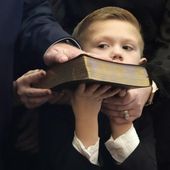OKLAHOMA CITY (AP) - The ‘89er Trail, a yearslong dream by developer Chuck Wiggin to share the story of Oklahoma City’s birth with visitors and locals, is finally a reality with all but a handful of markers now in place throughout downtown and Bricktown.
The signs are inspired by the Freedom Trail established in Boston, a city that Wiggin called home before moving to Oklahoma City in 1978. It wasn’t long after that the history enthusiast started digging into Oklahoma City’s unique start on April 22, 1889, and how a barren prairie turned into a city of 10,000 settlers overnight.
“This has been in the back of my mind since I moved to Oklahoma City,” said Wiggin, who owns the 101 Park Avenue Building across from the Skirvin Hilton Hotel. “I was fascinated that our history is recorded entirely in photos.”
Wiggin joined with Bob Blackburn, director of the Oklahoma Historical Society, several years ago to get the project started, the Oklahoman reported . The stories start on April 22, 1889, and show the good, the bad, the chaos and triumph of those early days.
The photos start with Oklahoma Station, the railway depot that was located where the city’s Santa Fe intermodal depot now stands at E.K. Gaylord and Sheridan Ave. Other signs tell the story of the city’s first July Fourth with a colorful poster urging people from across the country to visit the boom town on the prairie, a photo showing the first grandstands along with the story of how the celebration turned tragic when the grandstands collapsed.
More stops along the trail talk about the disputes in those early days that claimed the life of William L. Couch, the city’s first mayor and a “Boomer” who slipped in before the official start of the Land Run and staked out lots with his brothers.
Those following the trail will learn about the Native American side of this tale, the emergence of “Hell’s Half Acre” at what is now the site of the Cox Convention Center, and the failed attempt to build a “grand canal.”
Visitors will learn a lot of the early day action centered at Main and Broadway.
“Main and Broadway is significant,” Wiggin said. “It was where the first mass meeting was held on April 23, and it became the center of a lot of things politically that took place in the city. It was there they formed the citizens committee of 14 and a subcommittee to adjudicate lot claims. They dealt with the conflicting surveys.”
On May 1, 1889, the first election was held where Cotter Tower is now located. These stories and photos also are told along the ‘89er Trail.
Wiggin worked with the Oklahoma City Community Foundation to set up a fund, and the markers are owned and overseen by a new nonprofit organization. The research and text for the signs is being prepared by historian and author Michael Hightower while the signs were designed by Tulsan Carl Brune.
At Brune’s suggestion, Wiggin added Oregon-based Sea Reach Ltd. to advise on creating signs that could survive the extremes of Oklahoma weather.
“They’ve been doing these things for many decades for the National Park Service and I think they’re the best in the country,” Wiggin said. “They have a lot of experience and we listened to what they have to say.”
Wiggin had initially hoped to have the signs up three years ago. But the project required extensive reviews and permits from the city, and then awaited completion of Project 180 reconstruction of streets and installation of the streetcar tracks.
So far, 24 of the 28 markers are in place. Marker No. 11 on Main Street at the southwest corner of the Santa Fe Parking Garage and Marker 15 at the southeast corner of Sheridan and Hudson Avenues should be installed by summer as streetcar work is wrapped up.
Another two markers by the north end of the Skydance pedestrian bridge will be placed upon completion of Scissortail Park.
Downtown, declared dead by the Oklahoma City Council in the late 1980s, is now a popular tourist destination with destinations including Bricktown, the Myriad Gardens, the Oklahoma City Museum of Art, the Oklahoma City National Memorial and Riversport Adventure park along the Oklahoma River.
With the hotel count jumping from one to more than two dozen over the past 20 years, Downtown Oklahoma City Partnership reports the annual visitor count downtown at 7.5 million people.
About half of those visitors make Bricktown a stop in their stay and Chad Huntington, operator of the Bricktown Canal Water Taxis, interacts with a large sampling of that crowd.
Huntington believes the trail will become an important part of the visitor experience.
“The visitors we see every season come from very far-ranging parts of the U.S. and the globe,” Huntington said. “They are always interested in Oklahoma’s unusual history.”
The markers in Bricktown connect to two other significant monuments telling the story of Oklahoma City’s early days. The Oklahoma Land Run Monument is a series of heroic size sculptures portraying the rush of settlers on foot, horseback and wagon hoping to get a piece of land and start a new life.
A nearby sculpture by the Chickasaw Nation, meanwhile, tells the Native American side of the tale - one of lands taken away from tribes in Indian Territory and opened to later Land Runs and the origins of the “Unassigned Lands” where Oklahoma City was settled.
“Locals sometimes want to distance our identity from its pioneering and western aspects because every city wants to be seen as modern,” Huntington said. “However, the founding of Oklahoma City is very fascinating to outsiders and continues to have a continued impact on how our city develops.”
___
Information from: The Oklahoman, http://www.newsok.com



Please read our comment policy before commenting.